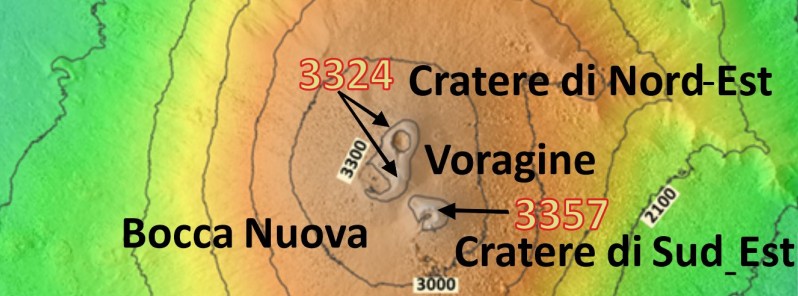Etna grows to record height of 3 357 m (11 014 feet), Italy

With approximately 50 paroxysmal eruptive episodes since February 16, 2021, Mount Etna has increased its height to a record 3 357 m (11 014 feet).
Eruptive events that took place in 2021 have accumulated significant amounts of pyroclastic material and lava layers on the cone of the Southeast Crater – the youngest and most active of the four summit craters of Etna, leading to a significant transformation of the shape of the volcano, INGV-OE reports.1
Thanks to the analysis and processing of satellite images, the Southeast Crater reached 3 357 m (11 014 feet) and is now far taller than its 'older brother' – the Northeast Crater, an undisputed summit of Etna for 40 years.
This historical data, which has a 3-meter (9.8 feet) uncertainty, was obtained through the processing of two Pléiades satellite images acquired on July 13 and 25, 2021, as part of the international partnership with Geohazard Supersites and Natural Laboratories (GSNL/), allowing Etna's digital surface model (DSM) to be updated.
To eliminate the effect of cloudiness, as well as the gas plume emitted by the summit craters, the DSM derived from the July 25 acquisition was supplemented with the DSM derived from the July 13 acquisition for the southeastern portion covered by gas in the summit area.
From the digital model obtained, the highest point of the volcano is now on the northern edge of the South-East Crater at 3 357 (± 3 m).

Images acquired by the Pleiades (resolution 50 cm) acquired on July 13 and 25, 2021. Credit: INGV-OE2
The summit of Etna, since 1980, has always been considered the Northeast Crater that reached a maximum height of 3 350 m (10 990 feet) with the paroxysms of September 1980 and February 1981.
This height decreased over the years due to the collapses in the summer of 2018 and it settled at 3 326 m (10 912 feet).
This record, however, has now been surpassed by the Southeast Crater cone and today Etna has a new summit.
Geological summary
Mount Etna, towering above Catania, Sicily's second-largest city, has one of the world's longest documented records of historical volcanism, dating back to 1500 BCE.
Historical lava flows of basaltic composition cover much of the surface of this massive volcano, whose edifice is the highest and most voluminous in Italy.
The Mongibello stratovolcano, truncated by several small calderas, was constructed during the late Pleistocene and Holocene over an older shield volcano. The most prominent morphological feature of Etna is the Valle del Bove, a 5 x 10 km (5.1 x 6.2 miles) horseshoe-shaped caldera open to the east.
Two styles of eruptive activity typically occur at Etna. Persistent explosive eruptions, sometimes with minor lava emissions, take place from one or more of the three prominent summit craters, the Central Crater, NE Crater, and SE Crater (the latter formed in 1978).
Flank vents, typically with higher effusion rates, are less frequently active and originate from fissures that open progressively downward from near the summit (usually accompanied by strombolian eruptions at the upper end).
Cinder cones are commonly constructed over the vents of lower-flank lava flows. Lava flows extend to the foot of the volcano on all sides and have reached the sea over a broad area on the SE flank.3
References:
INGV Vulcani – FB
Etna Weekly Bulletin (August 2 – 8, 2021) – INGV
Etna volcano – Geological summary – GVP
Featured image credit: INGV-OE

Commenting rules and guidelines
We value the thoughts and opinions of our readers and welcome healthy discussions on our website. In order to maintain a respectful and positive community, we ask that all commenters follow these rules.